
Trilobites are extinct marine arthropods that form the class Trilobita. Trilobites form one of the earliest known groups of arthropods. The first appearance of trilobites in the fossil record defines the base of the Atdabanian stage of the Early Cambrian period and they flourished throughout the lower Paleozoic before slipping into a long decline, when, during the Devonian, all trilobite orders except the Proetida died out. The last trilobites disappeared in the mass extinction at the end of the Permian about 251.9 million years ago. Trilobites were among the most successful of all early animals, existing in oceans for almost 270 million years, with over 22,000 species having been described.

Richard Alan Fortey is a British palaeontologist, natural historian, writer and television presenter, who served as president of the Geological Society of London for its bicentennial year of 2007.
Svalbardites is an extinct genus of trilobites. It lived during the Arenig stage of the Ordovician Period, approximately 478 to 471 million years ago.
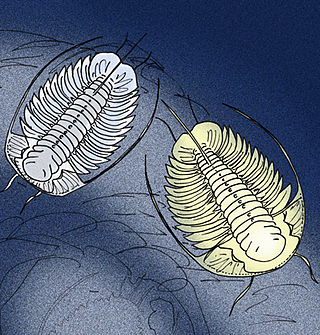
Balnibarbi is an extinct genus of trilobites in the family Olenidae. They are known from fossils excavated in Norway. They lived during the early part of the Arenig stage of the Ordovician Period, a faunal stage that occurred about 479 to 472 million years ago.
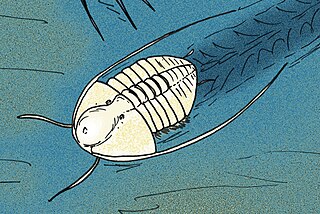
Globampyx is an extinct genus raphiophorid trilobites. It lived during the later part of the Arenig stage of the Ordovician Period, approximately 478 to 471 million years ago. Species of the genus are known from Canada, Norway (Svalbard) and Sweden.

Pytine is an extinct genus of asaphid trilobites. Species lived during the later part of the Arenig stage of the Ordovician Period, approximately 478 to 471 million years ago. Various species are found in the Svalbard, Valhallfonna Formation, Olenidsletta, Member, of Spitzbergen, Norway, the Megistaspis (Paramegistaspis) planilimbata Zone of the 'Shumardia Shale' of Sweden, Jujuy Province, Argentina, early Arenig-aged strata of Jiangxi province, China, and Darriwilian-aged strata in Western Hunan province, China. The type species, P. graia, has seven thorax segments, and lacks the rapier-like glabellar spine, that occurs in many other raphiophorids. The Chinese species, by contrast, have only six thoracic segments. So far, only the type species, and one of the Chinese species, P. laevigata, are known from complete specimens.
Thysanopeltis is a genus of trilobite that lived from the Early to the Middle Devonian. Its remains have been found in Africa and Europe.

Cheirurus is a genus of phacopid trilobites that lived from the Ordovician to the Devonian. Its remains have been found in Africa, Asia, Australia, Europe, and North America. Cheirurus is the type genus of Cheiruridae.
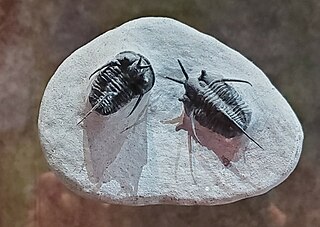
Cyphaspis is a genus of small trilobite that lived from the Late Ordovician to the Late Devonian. Fossils have been found in marine strata in what is now Europe, Africa and North America. Various species had a compact body, and a large, bulbous glabellum. Many species had long spines arranged similarly to closely related genera, such as Otarian, Otarionella, Chamaeleoaspis, and Namuropyge.

Norasaphus monroeae is a species of asaphid trilobites named after Marilyn Monroe for its hourglass-like shaped glabellum. Its fossils are found in Arenig-aged marine strata from the Nora Formation, in the Georgina Basin, situated between the Northern Territory and Queensland, Australia.
Annamitella Mansuy 1916 is a genus of trilobite, extinct marine arthropods. Annamitella lived from the Arenig to the Llandeilo age of the Ordovician Period from 478.6 to 460.9 million years ago.

Trinodus is a very small to small blind trilobite, a well known group of extinct marine arthropods, which lived during the Ordovician, in what are now the Yukon Territories, Virginia, Italy, Czech Republic, Poland, Denmark, Sweden, Svalbard, Ireland, Scotland, Wales, Iran, Kazakhstan and China. It is one of the last of the Agnostida order to survive.

Ogygiocarella Brongniart, 1822, is a genus of asaphid trilobites. It occurred during the Middle Ordovician.
Prospectatrix is a genus of trilobites of average size, that lived in the Lower Ordovician and is probably ancestral to the other genera of the Cyclopygidae family. Its eyes are only moderately enlarged and it has six or seven thorax segments.
Carolinites is a genus of trilobite, assigned to the Telephinidae family, that occurs during the Lower and Middle Ordovician. Carolinites had a pantropical distribution, and there is evidence that it lived in upper parts of the water column. The free cheeks of Carolinites are largely covered by its huge eyes, except for the attachment of large genal spines that extend downward, backward and lateral and gradually curving further backward. The glabella is slightly bulbous, the occipital ring is well defined, but further transglabellar furrows are lacking. The thorax has 10 segments. The axis of the pygidium is highly vaulted, with a curved spine emerging almost perpendicular to the midline and ending parallel to it and a node on each of the other three segments. Carolinites is known from what are today Australia (Tasmania), Canada (Alberta), China, France, Spitsbergen, and the United States (Utah).
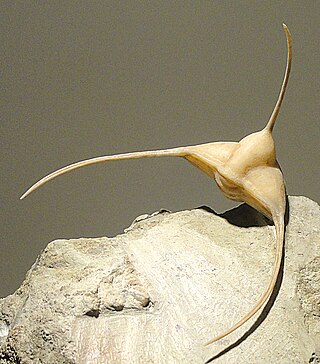
Raphiophoridae is a family of small to average-sized trilobites that first occurred at the start of the Ordovician and became extinct at the end of the Middle Silurian.
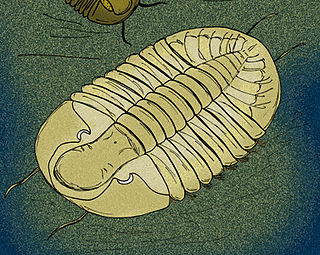
Gog is a genus of large, flattened asaphid trilobite from the Middle Arenig-aged Svalbard, Valhallfonna Formation, Olenidsletta, Member, of Spitzbergen, Norway, and the Upper Arenig-aged Dawan Formation in Hubei, China.
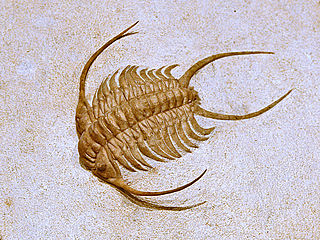
Paraceraurus is a genus of trilobites that lived in the Ordovician period. Its remains have been found in China, Estonia, Sweden and North America. These trilobites have a rounded and moderately convex cephalon. Glabella is convex or flattened, with a sub-rectangular outline. Thorax shows eleven segments.

Bulbaspis is a late Ordovician genus of asaphid trilobites of the family Raphiophoridae found primarily in upper Ordovician-aged deepwater marine strata of Kazakhstan, China, and possibly Tasmania. Species of Bulbaspis are similar to other raphiophorids such as Ampyx and Raphiophorus, save that the long spine that emanates from the glabella of the latter two genera has been modified into a knob-like or bulb-like structure in Bulbaspis that developed incrementally in the animal's growth. The function of the bulb is currently unknown: one hypothesis suggests sexual selection may have had a role in its evolution in the genus.
Aponileus is an extinct genus of trilobites. Chung-Hung Hu circumscribed the genus in 1963. The genus was once considered a junior subjective synonym of the genus Psephosthenaspis but it is considered to be a distinct genus again. As of 2021, fossils have been found in Greenland, Texas, and Utah. They all date to the Upper Floian (Blackhillsian) within the Ordovician Period.













